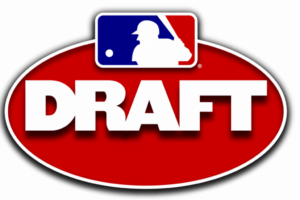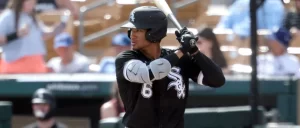A Tale of Two Outfielders: Courtney Hawkins and Jason Coats
Now why on earth would one want to compare Courtney Hawkins and Jason Coats, other than the fact that both are outfielders? Their tool kits are vastly different, as are their age & level. Their draft pedigrees aren’t in the same zip code, let alone ballpark. Where one is a top 10 or even top 5 prospect in the system, the other registers barely a blip on the back end of some of the longer lists, if that.
And yet, when you really take a deep look at the pair, you may find their value as prospects is much closer than you thought. Craziness? Read on, and see how you feel by the end of this article.
Let’s look at these two players’ back stories, then focus on tools and polish. The background is important because of age versus level if nothing else. We’ll then break it down into the prototypical 5-tool set: hit, hit for power, run, field, throw)…
BACKGROUND
Courtney Hawkins was selected as the 13th overall pick in the 2012 draft. Report cards at the time indicated a fantastic overall athlete with plus raw power, plus arm strength (threw in the low 90s as a pitcher) and above average speed. Hawkins went Rk-A-A+ in his draft year and posted good results doing it (.284/.324/.480, 11/16 SB/ATT, 22.5% K/PA), especially for a raw 18-year old much younger than his full-season peers.
Then in 2013 with a very aggressive assignment to the Carolina League, the big kid struggled mightily at the plate: .178/.249/.384, 19 HR but also a staggering 37.6% K/PA rate. Repeating at Winston-Salem after that disaster, Hawkins did improve quite a bit, though his numbers were still not exactly earth-shattering: .249/.331/.450, again 19 HR, 27.8% K/PA. As the White Sox are wont to do, they promoted the key prospect to AA despite being just 21. While perhaps not overwhelmed, he’s been walking on thin ice so far: .259/.340/.440, 6 HR, but a 31.4% K/PA in 43 games.
Jason Coats was taken in the 29th round that same year, and didn’t even play pro ball that season for the same reason his draft stock fell: a torn ACL late in his college season and surgical recovery. He was at one time projected in the top 10 rounds, and as a 23-year old he went straight to full-season ball in Kannapolis where he put up decent but not flashy numbers: .271/.320/.426 with 38 doubles and 12 home runs, stole 12 bags in 15 attempts, and struck out in 15.1% of his plate appearances.
Last year as an old-for-level 24-year old in Advanced A, Coats was the engine of the Dash offense hitting .291 while being among league leaders in doubles (35) and home runs (15) in 115 games, before a late-season promotion to AA. Here in 2015, Coats opened the year in AA Birmingham bat blazing, posting a .340/.354/.532 line with 9 doubles in just 12 games, when he was quickly promoted to top-level affiliate Charlotte. So far in AAA, he’s hitting for average again (.292), but the power and walks haven’t appeared yet (5 BB, 1 HR in 122 PA). He’s now closer to age-appropriate as a 25-year old in the International League.
HIT TOOL

Courtney Hawkins: This is the area of mystery, and the future-dictated tool, for the former 1st round pick. As it stands now, even after some improvements in 2014, he’s striking out 31.4% of the time in AA. Its important to note that he’s a young 21 years old for that level. But equally important, even with his improvements, he whiffed at a 27.8% rate while repeating A+. The walk rates are a bit more encouraging: 6.8% in his 2013 wreck, a solid 10.3% last year, and back down a bit to 7.4% this year. None are terrible numbers, and 2014 was good.
While he’s capable of hitting mistake breaking pitches hard, he still struggles to recognize them and swings at far too many out of the zone. He also struggles with inside fastballs and keeping his hands back.
Putting all that together, it’s hard to envision a hit tool at maturity much better than 40 on the 20-80 scouting scale, and he needs work to approach that. It’s not impossible to improve his pitch recognition and mechanics, but they are not easy to achieve either, especially the former. Right now he’s closer to 30 than 40.

Jason Coats: Coats’ lowest average at any level is .271, and it’s steadily gone up since through AA, now at .292 in AAA. Strikeout rates have been 15.1% in A, 13.7% in A+, and 12.0% in AA, but now are a little higher at 18.0% in AAA. The walk rates are a caution flag though, particularly this year: 5.5% in A, 7.4% in A+, and a lackluster 4.1% so far in AA & AAA.
In his case, the eye test matches the numbers – he will expand the zone, but his bat-to-ball skills are good enough to make up for it and he doesn’t seem to lunge or stretch from his typical swing. The current AAA walk rate won’t fly long-term, and in AAA his ability to put out-of-zone pitches in play will diminish if he doesn’t narrow his swing zone a bit. So here he gets a split score, as it’s hard to put an above average current tag on him without that adjustment. Give him a current 45 or 50, with room to be as high as 60 in the future in the “all goes to plan” scenario.
HITTING FOR POWER
Courtney Hawkins: Raw power is the carrying tool, and he’s a solid 70 here, putting him in elite territory. He hit 19 long balls in each of the past two seasons despite narrowing his window chasing so many pitches he couldn’t barrel up. The man hit a ball out of the park the other day and onto a moving train outside the stadium, and tape measure shots abound. This tool is where the largest gap exists between the two players. And where it may seem that a 15 HR guy and a 19 HR guy shouldn’t be that much different, remember that age versus level issue as well.
Jason Coats: While he lacks the high end raw power, Coats did hit 15 home runs each of the past two seasons, which was enough to be among league leaders at those levels in that category. This year the power has been oddly absent, going just over a hundred plate appearances in AAA and just recently hitting his first long ball. Hitters don’t usually see their power vanish like this in the minors unless there is a parallel struggle to put the ball in play, which is not the case here, so the concern about it disappearing is pretty small but worth noting. He’s got just OK leverage in his swing, but the bat comes out to the ball with surprising quickness and he’s line drive-oriented. He looks like a 10-15 HR/year guy with room for a little more if he can get more selective at the plate, so call him a 50 current grade with the possibility for 60 under ideal development.
SPEED
Courtney Hawkins: When drafted, the talk was that Hawkins had above average speed and could be a threat to steal 20 bags a year. But as he’s matured, the body has filled out quite a bit (which can be good and bad), and watching games you can see he’s just not got that kind of speed or acceleration. He did steal 11 bases last year and 10 the year before, and he’s not slow (so far this year he’s 1-for-5 on SB attempts). But he’s probably more 50-grade speed at this point, and as he gets older that’s more likely to go down than up. He’s probably an average runner if/when he reaches the majors, but trending down already.
Jason Coats: Jason has stolen fewer bases but has a better success rate. He’s not a speed demon either, nor will he be a big-time base-stealer, but he does have average to slightly above average speed on the bases. A scout also mentioned he’s aggressive with taking extra bags once he’s on. Coats is probably around the same grade as Hawkins here, though if Hawkins is 50-minus, Coats might be 50-plus giving him a slight edge.
FIELDING
Courtney Hawkins: Courtney is said to be spending a lot of time working on his defense, but even the most optimistic reports show him as perhaps an average fielder on the corners (with center out of the question). Range is OK, but route are rough at times. At this point he’s a tick below average, but average is within the scope of possibilities; 40 current, 50 projected.
Jason Coats: Similar speed gives Coats similar range, but having watched them both play and listening to some scouts, the routes and instincts are superior here. He looks like he’s likely above average on the corners, and he can and does play a little center in a pinch. Call him 55 or 60 on this grade.
THROWING
Courtney Hawkins: When he was working as a pitcher in high school, despite not focusing on it, Hawkins was hitting low 90s with his fastball. He’s also made some show-it-off throws as a pro. I haven’t seen enough play to comment much on accuracy. He’s got plenty of arm for either corner with room to spare. Scouting reports put him at 60 or 65 for his arm, and that sounds about right, and that small difference could be the accuracy variable.
Jason Coats: Coats doesn’t have the arm strength Hawkins does, but it’s close. And having watched him in outfield drills in Charlotte, he was putting on a show compared to his cohorts on throws to the plate, with good strength and striking accuracy. Again plenty of arm for any slot, he’s at least a 50 here, and might be closer to 60.
COMPARATIVE CONCLUSION
So let’s look at the grades I’ve assigned to these two:
Courtney Hawkins
Hit: 30/40, Power: 70, Speed: 50-, Field: 40/50, Throw: 60/65
Jason Coats
Hit: 50/60, Power: 50/55, Speed: 50+, Field: 55/60, Throw: 55
The two defensive grades offset to be a near-wash, maybe a slight win for Coats. Speed is very close, with again perhaps a slight edge to the same. The rubber hits the road with the hitting. Coats has a much better chance to collect hits in the majors than Hawkins, but the latter has that enticing power. Not all tools are created equal, and that power means a lot.
Courtney Hawkins’ ceiling was at one time considered a potential All Star, but at this point it’s hard to argue it’s higher than an average or perhaps slightly above average regular. The floor on the other hand is that he’s never able to hit AAA pitching. Coats’ ceiling is as a regular for short periods, especially with a lower tier offensive team. 4th outfielder or platoon partner are more likely, and he may already be near that 4th OF floor now. Each have open questions, but the potential range of results is much wider for Hawkins.
I’m not a big fan of player comps for minor leaguers, but if I have to go there… Courtney Hawkins is in many ways similar to Joe Borchard. The tools are similar, but Hawkins is doing things much younger per level so he’s maybe got a better shot at succeeding. For Jason Coats, perhaps a RHH Ross Gload on the offensive end (the hitting numbers are strikingly similar per level aside from Gload’s absurd 2000 season), but from an average or better fielding outfielder instead of primarily a 1B.
With the elite power tool and very good arm, Hawkins’ higher ceiling means he’s still the superior prospect. But I’d argue that Coats’ package of average to above average tools across the board give him a much better chance of being a contributing major leaguer of some kind, and that puts him not too far behind.
Want to know right away when we publish a new article? Type your email address in the box and click the “create subscription” button. Our list is completely spam free, and you can opt out at any time.





